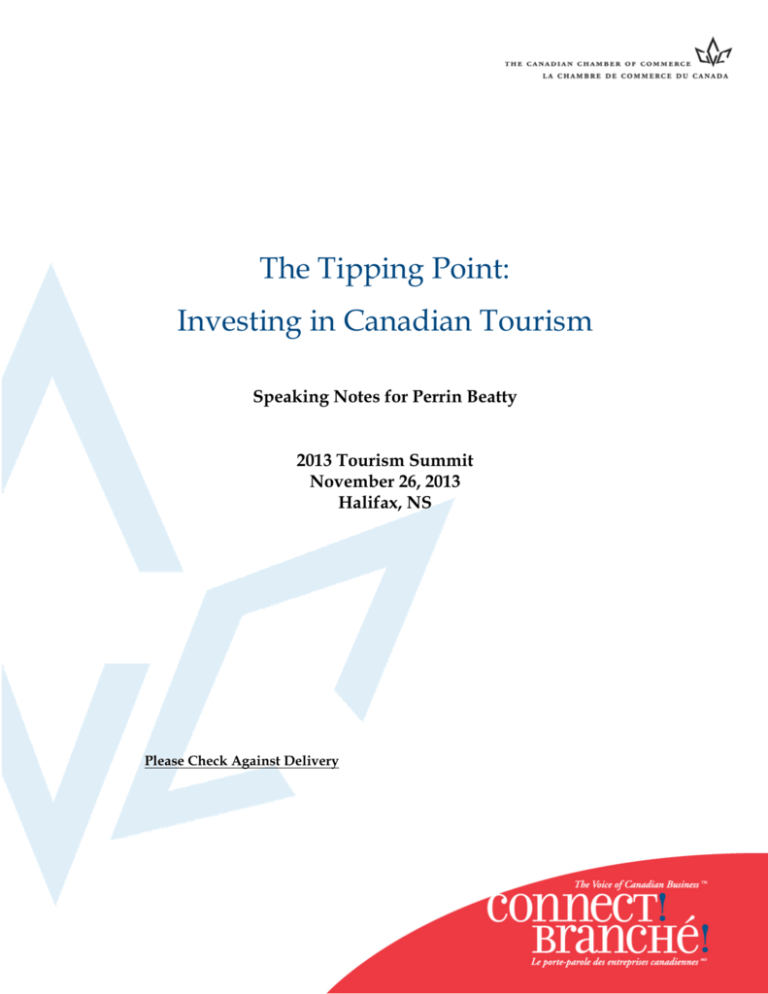The Tipping Point: Investing in Canadian Tourism
advertisement

The Tipping Point: Investing in Canadian Tourism Speaking Notes for Perrin Beatty 2013 Tourism Summit November 26, 2013 Halifax, NS Please Check Against Delivery Good afternoon and thank you for the kind introduction. It’s a real pleasure to be speaking to a group of people who are committed to strengthening the tourism industry in Atlantic Canada, and across the country. When I learned that Halifax hosts more pubs per capita than any other city in North America (although, St. John’s frequently tries to dispute this), I thought to myself: “Forget Peggy’s Cove, isn’t this enough to bring people to Nova Scotia?” Some of you might be aware that Nova Scotia’s provincial motto is: “one defends and the other conquers.” There is a strong relationship between the province’s motto and the reason we are convening today. It seems to me that the tourism industry spends a vast majority of its time defending a weakened Canadian industry, instead of conquering a world market that ought to be ours. I see the tourism industry at a tipping point in Canada. A tipping point is that [magic] moment when an idea, trend, or social behaviour crosses a threshold, tips and spreads like wildfire. The term became widely popularized by Malcolm Gladwell in his bestselling book, “The Tipping Point: How Little Things Can Make a Big Difference.” As Gladwell accurately points out, “the theory of Tipping Points requires that we reframe the way we think about the world.” I am not suggesting that we develop a utopian plan of action, but what I am going to touch on, is how applying the theory of Tipping Points is critical for how we reframe our tourism strategy, in order to successfully influence key decision makers to invest in this important sector of our economy. How have we reached a tipping point? A decade ago, we were one of the top 5 international tourist destinations, and now we find ourselves in danger of forfeiting our spot in the top 20. We are becoming increasingly uncompetitive within this sector, but we have the ability to influence the government to concentrate its resources in a few key areas. Reframing our approach is not only necessary, it is critical for tipping this industry into a state of growth and revitalization. One way in which the Canadian Chamber has successfully reframed this discussion is by launching an advocacy strategy entitled: Canada’s Top 10 Barriers to Competiveness. Started in 2012, this ongoing initiative aims to direct attention to the key impediments holding back Canada’s progress. We urge all levels of government to implement tangible solutions for breaking down barriers to our competitiveness, while simultaneously creating more opportunities for Canadians. In addition to identifying key policy areas such as skills shortages and internal barriers to trade, this past year, our organization pinpointed Canada’s tourism policies as a barrier to competitive success in this sector. There is hardly a community in Canada that is not affected by tourism, and many rely upon it as their economic foundation. Across the country, local chambers have been long supporting the sector because it provides direct and indirect employment to local communities. The Canadian Chamber released a discussion paper this past July that scrutinized the current state of the Canadian tourism industry. Many of you in the room are deeply aware that while the global market for tourism is growing at an astonishing rate, Canada’s share is shrinking. Our perspective is that Canada’s decline is not because it has suddenly become less beautiful, rather, Canada has failed to respond to changing realities within the tourism sector. Speech | The Canadian Chamber of Commerce 2 The Canadian Chamber has been working very closely with partners such as the Tourism Industry Association of Canada (TIAC), wherein we have combined forces to develop a cohesive strategy that will explicitly target the government to take a closer look, and apply a more critical approach to this vital sector of our economy. The Canadian Chamber and TIAC developed an advocacy project to highlight the issues with key stakeholders including government, media and the public. More specifically, we have highlighted how the tourism sector is intensely competitive, and Canada is not successfully competing. Areas such as transportation, real estate and realty finance, accommodations, food and beverage, meetings and events, and of course, attractions, are all downstream beneficiaries of a healthy tourism sector. I wrote to the Prime Minister in September, as the government prepared for their new session of Parliament. I expressed the view that the federal government has the opportunity to reverse the decline of the tourism industry, for the benefit of all regions in this country. Within this letter, I referred to the four main recommendations we included in our report. First, I asked the government to increase its investment in a federal marketing strategy. Canada’s marketing efforts must be substantially increased. Even doubled or tripled, the Canadian marketing budget would only represent a fraction of the revenues lost by the federal government as foreign visitors continue to rapidly decline. Next, I requested that a cross-sectional examination of the travel sector be performed, paying particular attention to the exorbitant costs borne by aviation customers. Only U.S. visitors drive to Canada, while all other countries depend on air travel. Canada has one of the most expensive air transport markets. User fees and levies on aviation add hundreds of millions to passenger costs. It also comes as no surprise that Canadians are driving across the border to catch flights that depart from U.S. soil. The visa application process also plays a fundamental role in this sector. Upgrading our visa application process to increase its capacity and reduce its complexity and inconvenience for potential visitors, would attract growth from countries such as Brazil, China, India and Mexico. Finally, Canada needs to implement the federal government’s tourism strategy, and ensure the environment is positive for investment in these critical tourism attractions. Whether it be financial or regulatory support, or just ensuring federal agencies and departments consider the tourism sector in their existing mandates—we need measures that reshape the sector so it can compete. Having written that letter with my collaborator David Goldstein, President of TIAC, I was pleased that the government included tourism as a federal priority in the Speech from the Throne in October. This was an important success for all of us in the room today. This is a direct response to our advocacy efforts on this critical file. Together, David and I recently wrote to the Prime Minister to thank him for including tourism in the Speech from the Throne. We encouraged the government to consider new means of cooperation among several ministries, such as Industry, Small Business and Tourism, and Finance. Moreover, we underscored that our associations from across the country stand ready to work together in increasing the contribution of the Canadian tourism sector. Now, the theme of your conference is “Getting Back to Business.” Our work is far from complete. We know our strategy is working, and the Chamber has been influential in bringing all of the Speech | The Canadian Chamber of Commerce 3 players together in this ongoing dialogue. The main change we immediately need to see is a strong commitment from the government in the 2014 budget. We are continuing our advocacy efforts, and the Canadian Chamber will also be including tourism in its Top 10 Barriers to Competitiveness publication in 2014. We realize that we have reached a tipping point, and we need to win over this issue in order to ensure that tourism is included in our next federal budget. It is crucial that everyone in this room continues to participate in this imperative dialogue, while encouraging the government to tip the sector into a direction that focuses on growth, prosperity and of course, on being fiercely competitive. The bottom line is that we need to make tourism a national priority. I would be delighted if every sitting Member of Parliament could not peacefully walk down the street without a member of the public stopping to ask them why we are not fixing the Canadian tourism sector. This is not only about maintaining our tourism industry; it is about conquering and revitalizing a sector that ought to be competing globally. There is no doubt in my mind that Halifax connects a vast number of Canadians. One in every five Canadians is related to someone who passed through Pier 21. This city in particular, wrote a chapter in the history of millions of Canadian lives, and has been the starting point for the new lives of entire generations. So perhaps this is also a great place to begin the fight to reclaim this industry, and launch the success of a new generation of Canadian tourism entrepreneurs. And while we continue to fight the good fight, together, we are responsible for tipping ourselves in the right direction. Speech | The Canadian Chamber of Commerce 4




